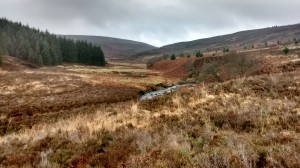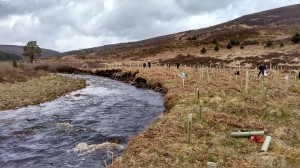By Katy Barke
Imagine standing in one of the wildest landscapes in England, looking up the valley and seeing Scots pine and native woodland stretching into the distance along a meandering burn. Black grouse forage below and golden eagles soar above…
This is the future we see for the land along the Scaup Burn at Kielderhead, stretching up to the Whitelee Nature Reserve and on towards the border.
I’m really excited to tell you all about a new project that we’re running in partnership with the Forestry Commission and funded by the Heritage Lottery Fund – the Kielderhead Wildwood. This is the first step of an ambitious vision to restore an area of native upland woodland about 5 miles northeast of Kielder village, along the Scaup Burn. As one of the most remote places in Britain, it is the ideal location for such a project.
Much of our upland woodland has been lost due to land-use change over millennia. Pollen analysis show that thousands of years ago a diverse woodland was supported in the area. The vision of Kielderhead Wildwood is to bring all this back, restoring natural processes and rebuilding a diverse and healthy ecosystem that will help with carbon storage and water quality. Over the next 5 years, my colleagues and our amazing volunteers will be planting tree species that we know used to be here. These include alder, birch, elm and willow, as well as Scots pine, of which a few ancient remnant trees are believed to have survived. By using local seed stock and giving nature a helping hand we will increase biodiversity and build a really resilient ecosystem. As the woodland matures, it will provide a home for declining, red-list upland bird species such as dunnock, mistle thrush, song thrush, tree pipit, woodcock and black grouse.
For me, this is an exciting opportunity to restore a habitat that was lost long ago because of human induced changes in the landscape. Visiting the site provides a wonderful sense of wildness and remoteness with the only sounds those of birdsong carried on the breeze and the trickling burn nearby. You can visit the site by walking out from Kielder Castle, but it’s quite a challenging hike. If you’d like to visit, keep your eyes on our website to see of any future guided visits, or better still take part in the project by volunteering and help to plant some of those trees yourself!
 This is just the start of our long term vision at Kielderhead Wildwood and I can’t wait to visit again in 20 years time to see the huge impact this project will have had on both the landscape and wildlife that can be found there. Kielder is an exciting place to work because of the sheer scale of the place. Home to the biggest man-made lake in northern Europe, the largest working forest in England and Europe’s largest expanse of protected night sky, Kielder truly is a spectacular place.
This is just the start of our long term vision at Kielderhead Wildwood and I can’t wait to visit again in 20 years time to see the huge impact this project will have had on both the landscape and wildlife that can be found there. Kielder is an exciting place to work because of the sheer scale of the place. Home to the biggest man-made lake in northern Europe, the largest working forest in England and Europe’s largest expanse of protected night sky, Kielder truly is a spectacular place.
Katy Barke is Kielder Living Landscape Manager, Northumberland Wildlife Trust

